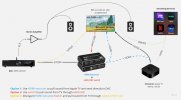ESS Sabre jitter reduction is good, but depends on its implementation. I have Aune X8 XVIII dac, which has not much tolerance. It is FPGA based but It also has ESS 9038QM chip. Some 9038QM based dacs have better jitter rejection.
Yes, my RPI4 with Kodi Libreelec and tv hat can decode DVB tv, because my Samsung TV produces dropouts on optical mainly with tv antena. But my TV hat was defective and I couldn't test It. I solved tv optical dropouts to the Aune by connecting to TV by USB port and It works!
Recently I bought another tv hat but I haven't got to try it. The audio quality difference is small. Optical and USB from tv sound different as well. My Ian Canada Transport PiDigi sounds a bit better than both. It is subtle (more resolution). Optical from tv sounds good as well, if it were not for the dropouts. DVB sound is low res, but movies sound better with the streamer, as does youtube (I did live switching). You need a good amplifier, dac and speakers to appreciate the difference nuance between inputs, but there sure is. You hit your gear limits easily. I have realized the amplifier is the most important element that limits sound quality. You can have the best dac but if your amp is bad you won't hear it's resolution.
I wanted a device that respected music files original 44.1 Khz sampling rate instead of 48 Khz resampling as the tv does. And even if you have jitter reduction built-in in the dac as Amir jitter tests show, me as for one, I prefer better clocked signal than having to dejitter it, because jitter correction also introduces noise. I realise in the end that the difference is subtle. I don't have good enough equipment to proper evaluation. A/B tests give me headache. Different digital inputs sound different: optical has more bass and midrange body that seem better quality, but I don't know if its rounding-up or not. It sounds like different eq presets. But Coax from RPi Digi Streamer seem to sound the best, detail-wise. I will tell you when I have a better amplifier and dac aswell. But I rest assured that my spidif transport is not limiting me. I hate the tv resampling my audio collection (or spotify app). And the tv has a lot of jitter, the proof is it produces dropouts with my dac that other digital sources don't. I also must confess that My Onkyo amp internal dac doesn't produce dropouts with my present tv. But it is inferior quality to the Aune X8.



